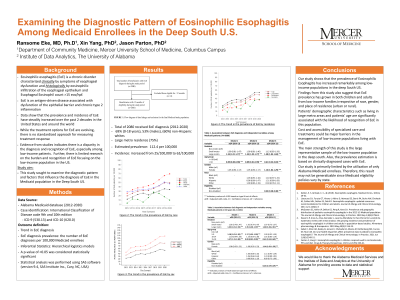Back


Poster Session C - Monday Afternoon
Category: Esophagus
C0221 - Examining the Diagnostic Pattern of Eosinophilic Esophagitis Among Medicaid Enrollees in the Deep South U.S.
Monday, October 24, 2022
3:00 PM – 5:00 PM ET
Location: Crown Ballroom

Has Audio
- RE
Ransome Eke, MD, PhD
Mercer University School of Medicine
Columbus, GA
Presenting Author(s)
Jason Parton, PhD1, Xin Yang, PhD1, Ransome Eke, MD, PhD2
1The University of Alabama, Tuscaloosa, AL; 2Mercer University School of Medicine, Columbus, GA
Introduction: Eosinophilic esophagitis (EoE) is a chronic, antigen-driven inflammatory disease characterized by clinical symptoms of esophageal dysfunction and histologic findings of increased eosinophilia levels in the esophagus. In the past two decades, it has transformed from a case-reportable disease to a disease widely recognized by physicians. A steady increase in incidence and prevalence has been seen in the United States. Still, there is limited information on the recognition of EOE in the low-income population. This study sought to examine the diagnostic pattern and factors that influence the diagnosis of EoE in the Medicaid population in the deep South US.
Methods: This study used Alabama Medicaid individual-level data, including claims, enrollee demographic, and geographic variables between 2012 and 2020. We used the International Classification of Disease code 9th and 10th edition to identify patients with the outcome variable of EoE diagnosis (ICD-9: 530.13; ICD-10: K20.0). Descriptive statistics were performed, using frequency and percentages to summarize categorical variables. EoE diagnosis prevalence was defined as the number of EoE diagnoses per 100,000 Medicaid patients. A multivariable logistic model was used to examine the association between EoE diagnoses and the independent variables. A p-value of < 0.05 was considered statistically significant. Statistical analyses were performed using SAS 9.4 software.
Results: 2,080 beneficiaries in the state of Alabama Medicaid program had a diagnosis of EoE between 2012 and 2020. The overall estimated prevalence of EoE in this population was 112.4 per 100,000, with a higher prevalence observed among non-Hispanic Whites, 97 per 100,000. The incidence of EoE increased from 25 per 100,000 to 62 per 100,000. A majority of the cases were children and adolescents (58%), non-Hispanic whites (60.1%), males (53%), and living in large metro areas (75%). Significant factors associated with a higher likelihood of a diagnosis of EoE were children compared to adults, females, and living in the large metro area compared to rural.
Discussion: The prevalence of Eosinophilic Esophagitis has increased among low-income populations in the deep South US. Patients’ demographic characteristics are associated with the likelihood of recognition of EoE in this population.
Disclosures:
Jason Parton, PhD1, Xin Yang, PhD1, Ransome Eke, MD, PhD2. C0221 - Examining the Diagnostic Pattern of Eosinophilic Esophagitis Among Medicaid Enrollees in the Deep South U.S., ACG 2022 Annual Scientific Meeting Abstracts. Charlotte, NC: American College of Gastroenterology.
1The University of Alabama, Tuscaloosa, AL; 2Mercer University School of Medicine, Columbus, GA
Introduction: Eosinophilic esophagitis (EoE) is a chronic, antigen-driven inflammatory disease characterized by clinical symptoms of esophageal dysfunction and histologic findings of increased eosinophilia levels in the esophagus. In the past two decades, it has transformed from a case-reportable disease to a disease widely recognized by physicians. A steady increase in incidence and prevalence has been seen in the United States. Still, there is limited information on the recognition of EOE in the low-income population. This study sought to examine the diagnostic pattern and factors that influence the diagnosis of EoE in the Medicaid population in the deep South US.
Methods: This study used Alabama Medicaid individual-level data, including claims, enrollee demographic, and geographic variables between 2012 and 2020. We used the International Classification of Disease code 9th and 10th edition to identify patients with the outcome variable of EoE diagnosis (ICD-9: 530.13; ICD-10: K20.0). Descriptive statistics were performed, using frequency and percentages to summarize categorical variables. EoE diagnosis prevalence was defined as the number of EoE diagnoses per 100,000 Medicaid patients. A multivariable logistic model was used to examine the association between EoE diagnoses and the independent variables. A p-value of < 0.05 was considered statistically significant. Statistical analyses were performed using SAS 9.4 software.
Results: 2,080 beneficiaries in the state of Alabama Medicaid program had a diagnosis of EoE between 2012 and 2020. The overall estimated prevalence of EoE in this population was 112.4 per 100,000, with a higher prevalence observed among non-Hispanic Whites, 97 per 100,000. The incidence of EoE increased from 25 per 100,000 to 62 per 100,000. A majority of the cases were children and adolescents (58%), non-Hispanic whites (60.1%), males (53%), and living in large metro areas (75%). Significant factors associated with a higher likelihood of a diagnosis of EoE were children compared to adults, females, and living in the large metro area compared to rural.
Discussion: The prevalence of Eosinophilic Esophagitis has increased among low-income populations in the deep South US. Patients’ demographic characteristics are associated with the likelihood of recognition of EoE in this population.
Disclosures:
Jason Parton indicated no relevant financial relationships.
Xin Yang indicated no relevant financial relationships.
Ransome Eke indicated no relevant financial relationships.
Jason Parton, PhD1, Xin Yang, PhD1, Ransome Eke, MD, PhD2. C0221 - Examining the Diagnostic Pattern of Eosinophilic Esophagitis Among Medicaid Enrollees in the Deep South U.S., ACG 2022 Annual Scientific Meeting Abstracts. Charlotte, NC: American College of Gastroenterology.
